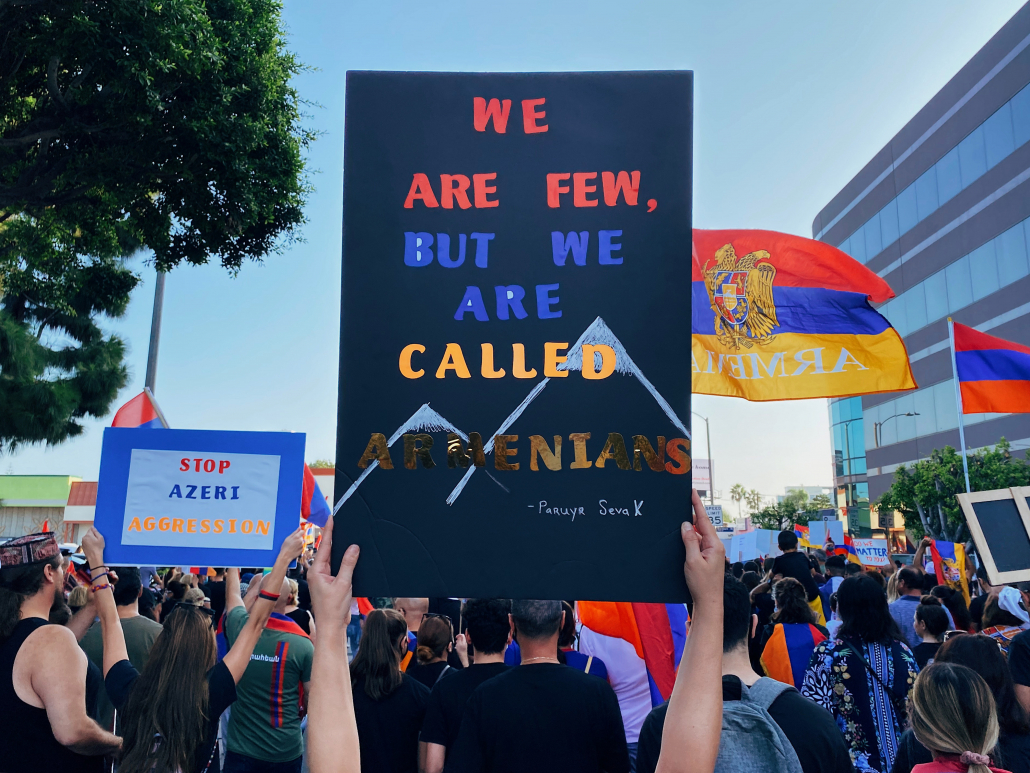Letter to the Editor: USC leadership must show solidarity with Armenian community
Throughout the last year, I have watched students from marginalized groups grapple with entrenched systems of racial violence and inequity, both on and off the USC campus. As an Armenian-American, dispossession, genocide and institutional erasure are familiar concepts to my community as well.
On Sept. 27, Armenians around the world woke up to a war in our ancestral homeland. Azerbaijan, with military support from Turkey, had launched a full-scale offensive against the indigenous Armenian population of the Republic of Artsakh, also known as Nagorno-Karabakh.
At the same time, Armenians living in the diaspora were targeted by numerous hate crimes, including the vandalization and shooting of an Armenian school and arson at an Armenian church in San Francisco, the desecration of an Armenian Genocide memorial in France and a march of nearly 300 Turkish ultranationalists in France who shouted, “We are going to kill the Armenians.”
The Second Artsakh War ended in a ceasefire on Nov. 9, in which Azerbaijan regained control of most of the mountainous enclave. At a victory parade in Azerbaijan’s capital of Baku, Turkish President Recep Tayyip Erdogan praised the Ottoman Turkish leader who orchestrated the Armenian Genocide that murdered 1.5 million Armenians from 1915 to 1923.
The Azerbaijani government has published stamps depicting the indigenous Armenians of Artsakh as pests and unveiled a museum that glorifies genocidal imagery of Armenians. Visitors to the “Military Trophy Park” in Azerbaijan enter through an alleyway constructed from the helmets of Armenian troops killed in battle. Inside the museum, multiple exhibitions feature highly degrading figurines of Armenian prisoners of war, many of whom are shackled and in the midst of death. Perhaps most disturbing were the images of Azerbaijani children touring the park, posing with seized Armenian military equipment and playing with the helmets of fallen servicemen.
Nearly 1,500 ancient Armenian historical monuments in Artsakh have fallen under the jurisdiction of the Azerbaijani government, which has already begun the process of erasing our cultural heritage. Both Turkey and Azerbaijan share a well-established record of destroying and illicitly confiscating Armenian heritage sites in the region. Between 1997 and 2006, the Azerbaijani government destroyed 89 Armenian churches, 5,840 khachkars (Armenian stone crosses) and 22,000 tombstones in Nakhichevan, a historically Armenian enclave controlled by Azerbaijan.
USC, which is in a city with one of the largest Armenian student populations in the country and has benefited from the talents and contributions of our community, has largely ignored the historical trauma that Armenian students are carrying.
From the onset of the 44-day Artsakh War, Armenian students demanded a substantive response to this tragedy that continues to affect so many of our lives. Instead, the administration relegated our pain to a Twitter thread that failed to rise to the gravity of the situation. What is the purpose of removing the names of problematic figures from our buildings and announcing diversity initiatives if you cannot speak out against atrocities in real time?
While the administration largely remained silent during the war, fellow students supported us. Every cultural affinity group at the Gould School of Law co-signed the Armenian Law Students Association’s joint statement on Artsakh. I was humbled by the strong statements issued by USC’s Undergraduate and Graduate Student Governments, who unequivocally stood behind the Armenian community.
Even in April, designated as Armenian History Month in Los Angeles County with Armenian Genocide Remembrance Day commemorated on April 24, the University has failed to meaningfully include Armenians in its recent commitments to diversity, equity and inclusion. Instead, Armenian students at USC must continue to bear the responsibility of educating our University about our experiences and history.
As leaders of an elite research institution that hosts one of the largest archives of genocide survivor testimonies, the USC administration must set an example for the academic community and demonstrate how serious it is about justice, inclusion and confronting uncomfortable truths. The eyes of history, and those of USC’s Armenian students, faculty and alumni, are upon you.
Maral Tavitian is a second-year law student at the Gould School of Law.


